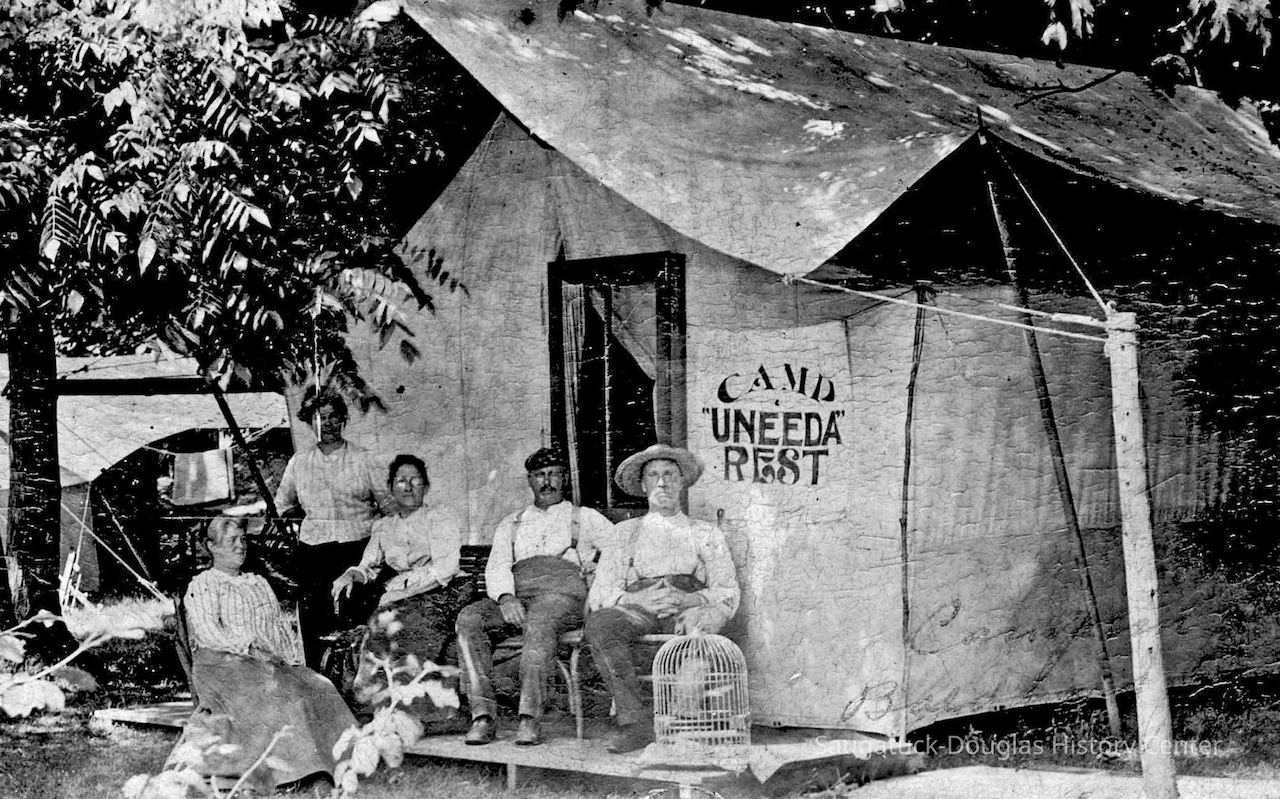
SAUGATUCK, MI — Some things are timeless − the simple pleasure of packing up the tent and setting off to enjoy nature. But when camping was in its early days it wasn’t always rustic. Photos and postcards show glamping has always been a tourist draw along Michigan’s lakeshore.
Saugatuck started to bill itself as a tourist destination after 1850 and the sandy slope of Mount Baldhead became a new sort of landmark.
Visitors made the base of Mt. Baldy a destination all its own as they developed Camp UNeeda Rest.
Postcards and photos collected by the Saugatuck-Douglas History Center show the earliest rendition of “glamping” with wooden-floored tents, rugs and easy chairs set out for campers to rent for $1 per month.
The camping outfits are far flung from today’s shorts and a t-shirt. Men camped in their slacks and suspenders and ladies in their ruffled collars and floppy sun hats.
In addition to hammocks, loungers and stacks of books, the 19th century camping checklist also included a train or steamship ticket.
Travelers were most likely from other Midwest cities like Chicago, St. Louis or Indianapolis, said Eric Gollannek, the history center’s director.
“People from all around the region came here and make the story quite lively and rich,” he said.
These tourists were “vocal,” Gollannek said, writing home about their experiences.
One recovered Camp UNeeda Rest postcard sent to a Chicago address recounts “a dandy time and a good rest.”
Mt. Baldy’s now infamous stairs and an observation tower overlooking Lake Michigan were built in 1884. This further drew in tourists and created Saugatuck’s legacy as a beach town.
In the 1900s, Saugatuck’s Rosemont Inn and Beechwood Manor Inns open and become anchors for the town’s tourism. Both still operate today.
“What’s interesting from a historical perspective is that many of these photos survived because families who came as campers eventually went on to buy land and build cabins or cottages in the same area along Park Street and the Kalamazoo River,” Gollannek said.
The growing accessibility to transportation widened the pool of campers, but it still had Gollannek wondering why people were drawn to camping.
“Why are people in the late 1800s so interested to go out in the woods, live in a tent, fish and cook their own meals − particularly the upper class,” he said. “It’s because industrialization has made life a lot like our life is today. It’s stressful.”
Folks in the 19th century were talking and writing about returning to the simpler life as they watched the world change again during the Second Industrial Revolution.
Although Gollannek notes the improvements in technology, like railroads and luxury steamships, are what literally brought them back to nature.
“Getting back to some simpler way of being, more closely connected to nature, away from the modernity is a big reason why people are coming to Saugatuck-Douglas,” he said. “It’s some of the same rationale and same reasons [as today.]”
After you climb the 303 steps to the panoramic overlook at Mt. Baldy, consider taking a few more steps to the Saugatuck-Douglas History Center, just across the street from the parking lot.
The Lure of Mount Baldhead exhibit takes visitors back to the 1800s when the site was used for ceremonies for Indigenous tribes, fitness races, camping and skiing.
See the full gallery of Camp UNeeda Rest photos below.



